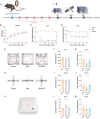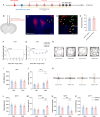Environmental enrichment alleviates neuropathic pain-associated anxiety by enhancing the function of parvalbumin interneurons in the anterior cingulate cortex
- PMID: 40128579
- PMCID: PMC11933386
- DOI: 10.1038/s41598-025-95220-6
Environmental enrichment alleviates neuropathic pain-associated anxiety by enhancing the function of parvalbumin interneurons in the anterior cingulate cortex
Abstract
Chronic neuropathic pain is often accompanied with comorbid anxiety. However, effective interventions for this anxiety are highly limited. This study aims to examine the effect of environmental enrichment (EE) on spared nerve injury (SNI)-induced neuropathic pain-associated anxiety behaviors and explore the mechanisms underlying this effect. EE effectively ameliorated anxiety-like behaviors followed by SNI. EE also significantly reversed the phenotypic loss of parvalbumin (PV) interneurons in the anterior cingulate cortex (ACC) and impaired gamma oscillations under SNI-induced neuropathic pain conditions. In addition, EE reversed the SNI-induced reduction in the number of PV puncta around Ca²⁺/calmodulin-dependent protein kinase II-positive neurons. Furthermore, enhancing the function of PV interneurons could effectively improve the SNI-caused anxiety-like behaviors. In contrast, the inhibition of PV interneurons led to anxiety-like behaviors in naïve mice. Our findings suggest that EE significantly improves anxiety-like behaviors under neuropathic pain conditions, likely by enhancing the function of PV interneurons in ACC.
Keywords: Environmental enrichment; Gamma Oscillation; Neuropathic pain; PV interneurons.
© 2025. The Author(s).
Conflict of interest statement
Declarations. Competing interests: The authors declare no competing interests. Ethics approval: All experiment received approval from the Animal Care and Welfare Committee of Zhengzhou University.
Figures







References
-
- Finnerup, N. B., Kuner, R. & Jensen, T. S. Neuropathic pain: from mechanisms to treatment. Physiol. Rev.101(1), 259–301 (2021). - PubMed
-
- Feingold, D. et al. Problematic use of prescription opioids and medicinal cannabis among patients suffering from chronic pain. Pain Med. (Malden Mass). 18(2), 294–306 (2017). - PubMed
-
- Zhuo, M. Neural mechanisms underlying anxiety-chronic pain interactions Trends Neurosciences39(3), 136–145 (2016). - PubMed
-
- Sztainberg, Y. & Chen, A. An environmental enrichment model for mice. Nat. Protoc.5(9), 1535–1539 (2010). - PubMed
MeSH terms
Substances
Grants and funding
LinkOut - more resources
Full Text Sources
Medical
Miscellaneous

